High on the Zollerberg mountain in the Swabian Alb lies Hohenzollern Castle. It is visible far across the country and is one of the most famous sights in the region.
Hohenzollern Castle is the ancestral seat of the Hohenzollern family. The ruling Prussian kings and emperors once belonged to the princely dynasty.

Short castle history
Already in the Middle Ages there was a castle on the Zollerberg. However, this was completely destroyed in 1423 after a conquest.
Around 1454, the construction of a strongly secured fortress castle began. However, this fortification could not prevent the Württemberger from capturing and occupying the castle during the Thirty Years’ War. The customs troops stationed there at that time were given free leave and the principality of Hohenzollern-Hechingen had to pay homage to Eberhardt von Württemberg. A short time later, after the Battle of Nördlingen, the balance of power was turned in favor of the Emperor and the fortress was recaptured. After the end of the war, the castle was mainly owned by the Habsburgs.

In 1798 the last Austrian garrison left and the castle became more and more dilapidated. At the beginning of the 19th century there was actually only a ruin on the mountain. Only the chapel of St. Michael was preserved.

The Hohenzollerns are coming
When the crown prince and later king Frederick William IV passed through the Swabian Alb on his way to Italy around 1819, he also passed the ruins of the castle. He perhaps also climbed the mountain to learn something about the roots of his ancestors. In any case, the sunset up there must have impressed him immensely. A few years later (1844) he was still raving about it and wanted to make the castle habitable again.

The Berlin architect Friedrich August Stüler designed Hohenzollern Castle, as it exists today, in the neo-Gothic style. He was assisted by one of the leading German fortress architects Moritz von Prittwitz (driveway) and the sculptor Gustav Willgohs.
The foundation stone was laid in 1850 and the building was inaugurated in 1867.
Hohenzollern Castle, as it had been built, did not please all the Hohenzollerns. For example, Kaiser Wilhelm II commissioned an architect to redesign the castle in the style of historicism. The architect visited the estate and recommended a new building, since in his opinion the original structure could not be remodeled. The emperor then decided to leave everything as it was and put the money into other building projects.

On 3.9.1978 there was an earthquake in the region that severely damaged Hohenzollern Castle. Restoration work continued for many years, and restoration work on the outer walls of the bastions was also underway during our visit.
Visit to Hohenzollern Castle
Already on the approach to the castle you have a great view high up. If you arrive at the foot of the mountain, a road winds up a few meters until you reach a large free parking lot. Here you have to leave your car, because it is not possible to drive up to the castle entrance.
At the parking lot there is an information desk and the ticket office. Especially on weekends and in the high season, it is recommended to buy tickets online in advance. The number of visitors is limited and the rush at this time is particularly large.

From the parking lot you have two options to get to the castle: walking or by bus. The way up is steep and there are many steps, who is good on foot needs about 20 minutes. It is easier to take the free minibus. The bus stop is right in parking lot 1 and the bus departs regularly and as needed. But do not forget – buy the ticket in advance, directly at the castle entrance is not possible!

We went up by bus, which winds its way up the steeply rising road and stops just a few steps away from the Adlertor, the main entrance to the castle. There is then the entrance control and you enter the castle grounds.
Path through the fortification
Through the impressive eagle gate you enter the castle complex. One should not miss to take a look upwards. One can discover the coat of arms with the Prussian eagle and the motto of the Hohenzollerns (“From the rock to the sea”) at the gate. In addition, in the gable field you can see the Brandenburg Elector Frederick I on horseback and a saying about the history of construction.
The castle courtyard is reached via the driveway. The master builder had to take into account in his planning that the height difference of about 25 meters would also have to be overcome by carriages and carts. It designed three overlapping elliptical loops, which you walk up today. On the way you pass through several gates and walk over drawbridges that secured the way.

The way up impresses me very much. It goes up partly through vault-like corridors until you reach the uncovered driveway. Here the view of the castle complex opens up.
The bastions
We were first drawn to the path that leads around the castle building. Due to the construction work on the outer wall, only a part of it is currently accessible, but it reflects very well the structure of the complex.

Each bastion has its own name and on the grassy paths between them are statues of Prussian kings and emperors . These originally stood in the Hall of Fame in the Berlin Armory.

The view of the surroundings is impressive. A wide almost flat area stretches in one direction, while in another direction the ridge of the Swabian Alb rises. I even think I recognized the spot where I had been standing just a short time before, enjoying the view of Hohenzollern Castle on a hike.
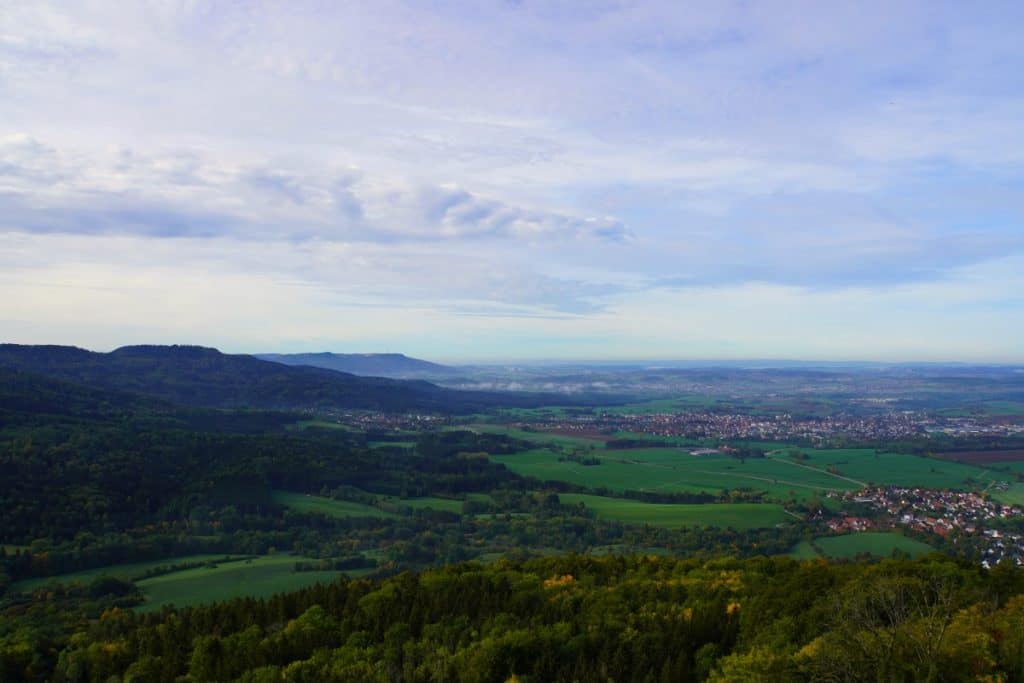
The castle courtyard
The castle building encloses the castle courtyard, which is 855 meters above sea level, like a U. In the former castle garden there is now a beer garden, which is always very well visited in the summer months.

The castle building has an interesting structure. At the ends of the “U” there is the Catholic chapel on one side and the Protestant chapel on the other. Directly adjacent to the Protestant chapel is the former fortified house. Today it is used by the museum store, the administration and the restaurant.

The whole ensemble of buildings is characterized by turrets and pinnacles. There are four main towers (Emperor’s Tower, Bishop’s Tower, Margrave’s Tower, Michael’s Tower) and in the castle courtyard there is the Wart Tower. This is a stair tower, which stands by the princely building.
When a flag flies on this tower, the lord of the castle is present. During our visit there was no flag flying!
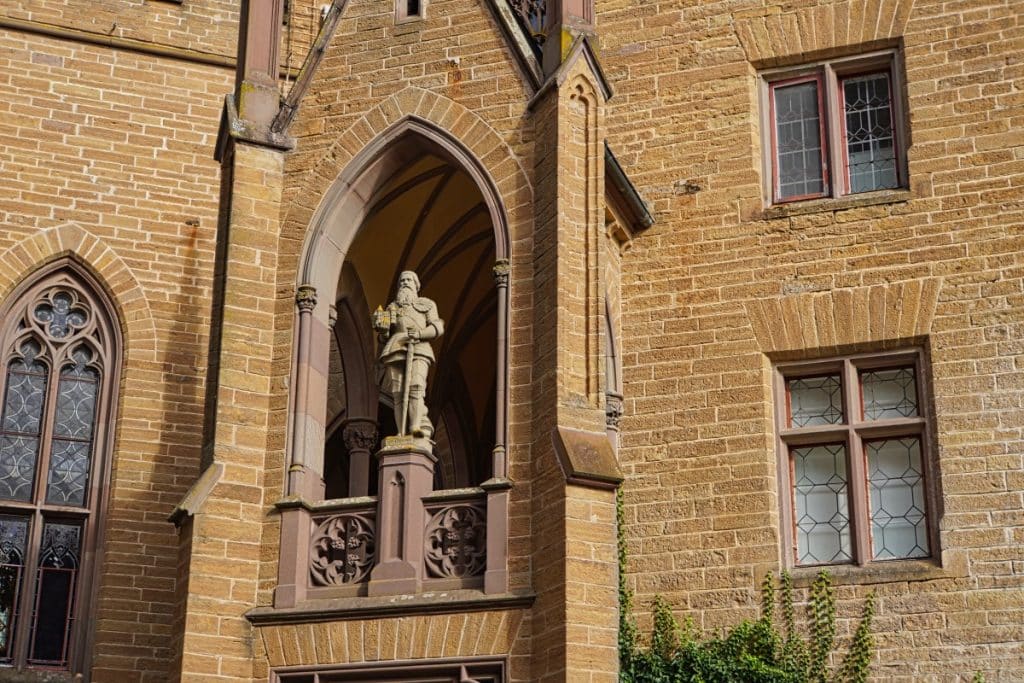
The large flight of steps leading into the building is impressive. Above the staircase is a life-size statue of Count Jost Nicklas von Zollern. In his hand he holds a model of the second castle built by him. If you go up the stairs, you enter Hohenzollern Castle and can experience a great tour of the building.

The tour of the castle building
Before you go on the tour, you should definitely download the app with the audio guide on your phone. I found the explanations of the individual areas very interesting. Of course, you can also read the information on the signs in the building.
The tour starts in the pedigree hall. My first thought when looking at the walls – “I want that too” – my second thought “wow, what a job”. The walls in this room show a painted family tree of the Hohenzollerns from the 11th century. All members of the dynasty up to the present are shown. If you are looking for a specific person here, you have to look very closely!
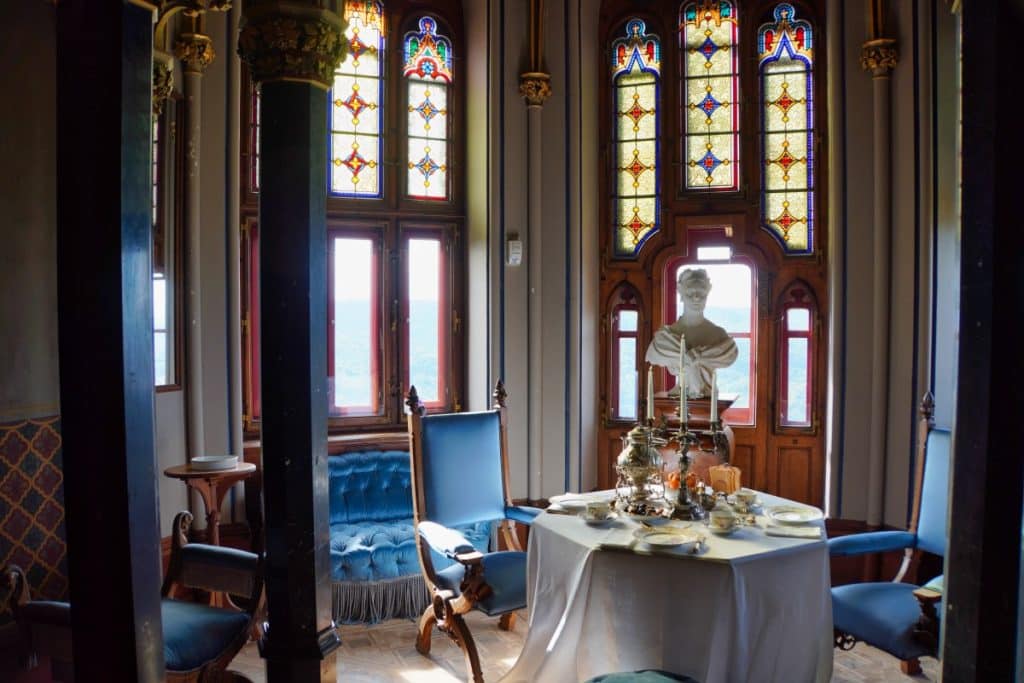
From the Hall of Family Trees you can enter the Count’s Hall, the castle’s banquet and dining room, through a double door. This room is the largest room in the castle. What I find impressive are the reddish marble columns that support the high pointed-arched ribbed vault. It looks somewhat like a church, if it weren’t for the large windows and the huge chandeliers on the ceiling.

From there, the tour continued through the former library, through various private chambers to the queen’s drawing room. Everywhere there is something to discover. From paintings about the history of the castle or people to furniture and objects from the family estate. Once in the queen’s salon, you should also take a look out the window. Here you have a great view of the Albtrauf.
Why does Hohenzollern Castle have three chapels?
After visiting the interiors, we were drawn to the chapels of the castle. There is a Protestant chapel and a Catholic chapel, both of which can be visited, and a Russian Orthodox chapel, which cannot be visited.

St. Michael’s Chapel is Catholic and the only preserved building of the second castle. It thus dates from 1454 to 1461 and was extended around 1853. The lead-glazed painted windows date back to the 13th century and came to Hohenzollern Castle in the 19th century. They were previously in the church of the Stetten monastery, which for a time housed the Zollerian hereditary burial ground.
Stüler was commissioned by King Frederick William IV to build the Protestant Christ Chapel. This was to accommodate the different faiths of the family. The Apostle Gate comes from the destroyed Kaiser Wilhelm Memorial Church in Berlin. The coffins of Frederick the Great and Frederick William I stood in the church from 1952-1991. After the German reunification they were transferred to Potsdam.

Under the Christ Chapel is the Russian Orthodox Resurrection Chapel, which was established by Prince Louis Ferdinand of Prussia for his wife Kira of Russia. Her grave is also located there.
Treasury
The Hohenzollern family treasury can be reached via a separate entrance.
Well protected in display cases, you can see here, for example, the tunic of Frederick the Great. It’s funny how a name creates an image in the mind. I had a tall handsome man in mind, but the tunic was so small that it would rather fit me.
The highlight is the crown of William II. This is decorated with diamonds and diamonds and corresponds exactly to my idea of a royal crown!
Casemates
Via a descending staircase we reached the casemates. These were discovered only in 2001. They are bomb-proof recreation and storage rooms of the medieval castle. In the former utility rooms, which are located under the former kitchen, you can see historical tableware. On special occasions they are used even today.
A narrow spiral staircase leads even deeper under Hohenzollern Castle. Here are rooms that were used as shelters during the siege of 1632.
A new staircase then leads back out into the open and you are standing on the bastion.

Address:
72379 Burg Hohenzollern
Opening hours:
Castle complex:
daily 10-18.30h
Showrooms:
daily 10-18 h
Admission fees:
Adults: 22,-€
Good to know
Yes, there are two large free parking lots available.
Between the parking lot P1 and the castle runs a free shuttle bus. The parking lot P2 is only opened in case of need and then also served by the shuttle bus. The bus stops in front of the Adlertor. From there it is about 400 meters through the driveway (uphill).
The fare is included in the ticket price.
The bus runs daily from 10-18 o’clock. There may be restrictions in the operation due to weather conditions.
Yes, from the parking lot P1 a signposted hiking trail leads to the Adlertor. The path is partly very steep and you have to climb numerous stairs. It takes about 25 minutes to climb up to the castle.
By car you can reach the castle via the A 81 Stuttgart-Singen. Take the exit Empfingen and then drive on the B 463 in the direction of Balingen. Turn onto the B 27 to Hechingen and take the exit Hechingen Süd. From there at the latest, Burg Hohenzollern is signposted. The access road to the castle leads directly to the parking lot.
Take the Deutsche Bahn to Hechingen train station. From the station, take line 306 and the Traufbus (line 344) to the parking lot of the castle. From there you can then take the shuttle bus.
The castle visit was an agenda item of a research trip to Albstadt. The photos are used with the kind permission of the PR & Media department of Hohenzollern Castle.




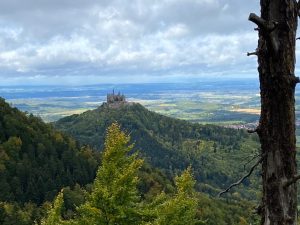

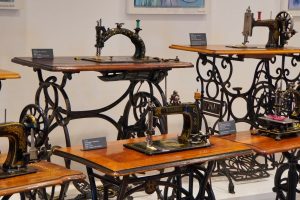

Leave a Reply